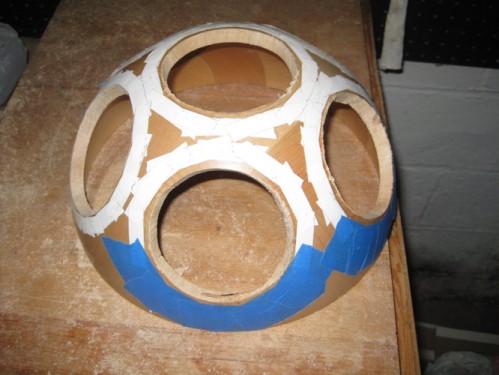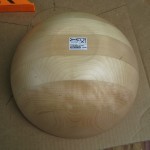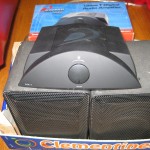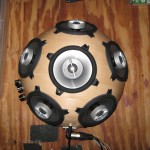Here are live recordings from this spring’s Parkside performance with John Wiese, Steve Jansen and Brad Davis. This is from my buzzy, noisy Radicans project which uses small motors and soundbug transducers (audio speakers without cones) to transform ordinary objects in the performance space into speakers.
Tag Archives: speaker
No more clunky JBL EONs
My JBL EON G2 10s have served me well as a small PA or as monitor speakers, until they suddenly developed a nasty rattle. At first I thought I’d blown a woofer, but a quick inspection behind the grill showed everything was in order. Then I noticed that something inside each speaker was loose–it would make a disturbing clunk sound whenever I moved it. So I pulled the back off (so many screws…) and discovered the toroidal transformer was loose. I applied a dab of Loc-tite, tightened the bolt, and reassembled the speakers. Now they’re rattle free!
Salad Bowl Hemi Speaker #2
I recently completed my second salad bowl hemi speaker. (See info on the first one here, including links to the Princeton and Stanford laptop orchestras which provided excellent guides to construction.) My second speaker followed the design and construction of the first very closely, with the substitution of Polk Audio DB401 speakers. The Polk speakers were significantly cheaper than the Infinity speakers. I haven’t directly compared the speakers, but I remember the Infinity speakers to be heavier and louder than the Polk speakers. The frequency response of both seems very similar. I do prefer the mounting tabs on the Infinity speakers to the broad flange on the Polk speakers. When mounting them on a hemispherical surface, the Polk speaker flanges don’t lie quite as flat (er…curved).
Here are some photos I took during construction.

This is the bottom of the speaker. I simply scribed the circumference of the bowl on a piece of 1/2″ plywood and cut out the circle using a jigsaw.

Salad bowl with speaker holes marked and taped
Here’s the bowl with the position of each speaker marked and taped. If you look closely you can see a small red mark at the center of each circle. I used a string attached to the center of the bowl to mark the center of all the equatorial speakers. The tape is simply to prevent the bottom of my jigsaw from scarring the surface of the bowl.

Salad bowl with holes drilled for jigsaw blade
Next I drilled holes in each speaker cutout large enough to fit the blade of my jigsaw.

Salad bowl with speaker holes
Here’s the bowl with all the speaker holes cut. It’s easy to crack the salad bowl after removing so much of the material, so take care with all subsequent drilling and cutting.

Detail of cut used to enlarge back of speaker opening
One result of working with the elliptical geometry of a hemisphere is that the back side of the holes we cut is slightly smaller than the front side. This might prevent your speakers from sitting flush against the surface. I only needed to trim a few places from the back of each circle to get the Infinity speakers to mount flush, but I had to cut the entire back edge of each opening in order to mount the Polk speakers.

Finished hemi showing knobs and connections
Here’s the finished speaker. (I know, I skipped plenty of intervening steps! I was having too much fun putting all the pieces together to stop and take pictures.) The volume knobs (one for each stereo amp) are on the left. In the middle is the power connector. On the right is a 6-conductor Neutrik connector for all the audio signals.

Finished hemi on top of subwoofer
A front view of the finished speaker. It’s sitting on top of a Sony subwoofer I picked up at a yard sale. The two together have a nice R2-unit look. I’ve set the crossover fairly high (around 300Hz). I expect I’ll back it down after some more listening tests.
I’ve already performed once with this hemi. So far, the biggest problem I’ve encountered is having the amps cut out on me when the input levels get too high. The Dayton amps seem to have a protection circuit that shuts them down when they’re driven too hard. It’s better than having the amps blow up, to be sure, but a bit of a drag having the audio suddenly drop out. Sending the low frequency signals to the sub seems to ease the load placed on the hemi amps. I’ve also been experimenting with limiters and high-ratio compressors, but I haven’t yet found the silver bullet. I’ve only scratched the surface of spatialization possibilities with this setup, and I’m looking forward to working with it even more.
Retweeting. No, really.
A few months ago I blew a tweeter on one of my Fostex PM2 MkII monitors. What should have been a simple repair turned into a marathon. First, Fostex recently sold all support and distribution to a new US company who was slow to respond to repair inquiries due to the backlog created during the handover. They finally came through with a list of local(ish) authorized dealers/repair sites. The closest of which was a known and trusted music shop who never returned my calls–I guess they’re doing fine in this economy. So I struck out on my own. Given my limited budget, doing it myself seemed like the best approach anyway.
After a few consultations with the excellent tech team at iEAR, I had the tweeter removed, verified that it was indeed the problem, and gathered enough information to purchase replacements. I then headed over to Madisound to choose replacement tweeters. Support at Madisound was exemplary–a quick phone call yielded a handful of recommendations for replacement tweeters.
I opted for the SEAS Prestige 27TDF (H1211) tweeter. I’m no audiophile speaker-building veteran, nor could I reasonably measure the frequency response of the factory tweeters. So my choice was determined by finding the closest physical match of diaphragm size, outside diameter, etc. Oh, and budget was a concern, too. I could have spent more on tweeters than I paid for the monitors themselves. $33 each seemed about right. I bought two, realizing that the likelihood of a perfect match was slim–the goal was to replace both tweeters with acceptable sounding units.
Installing the tweeters was mostly straightforward. I used my trusty dremel to carve out a little space in the opening for the new tweeters’ connectors. The only mystery was the polarity of the wires going to the tweeters. I connected the tweeter both ways and listened for differences. The correct wiring was readily apparent: upper mid frequencies all but disappeared when the polarity was reversed.
So, how do the new tweeters compare to the factory tweeters? On the whole, favorably. They’re noticeably quieter; I had to increase the tweeter gain by about 7 dB to get the new tweeter to match the factory unit. Their performance is less consistent at lower volume levels, with the lower range of the tweeter much less prominent when listening at lower volumes. But when I turn up the volume the response flattens out considerably and the difference between the tweeters becomes almost imperceptible. One reason I liked the Fostex monitors to begin with was their balanced sound at low listening levels. I’m disappointed to lose some of that clarity, but pleased that the speakers’ overall character is not radically changed when listening at more typical levels.

Here are the speakers on my workbench with a new tweeter installed on the left and the old one on the right.
I’ve been listening and mixing with the retweeted speakers for about 10 days now and I feel like my old monitors are back in the studio.
Hemi Speaker and Our Lady of Detritus
I recently had the opportunity to help Kristin Norderval build a hemispherical speaker for use in the jill sigman/thinkdance production, Our Lady of Detritus, engagingly described as “a portable, interdisciplinary performance installation about trash and transcendence; a traveling grassroots campaign fueled by experimentation, green energy sources and community interaction.” The show is presented every weekend through mid-October at various locations around New York City. See here for details.
The speaker was based on the Princeton Laptop Orchestra (PLOrk) Delorean speaker and the Stanford Laptop Orchestra (SLOrk) speakers.
Enclosure
We used an Ikea salad bowl for the enclosure just like the SLOrk speakers.
Amps
We pulled 3 Dayton T-amps from their enclosures and mounted them on the inside of the bottom plate of the speaker cabinet.
Speakers
We used 6 4″ Inifinity 4022i drivers.
Volume Pots and Connectors
The Dayton amps had combination volume and power pots, so we decided to keep them rather than source and wire up a 6-position potentiometer. A little Dremel routing magic made mounting the volume pots easier than I expected. A coaxial power jack and 6-pin Neutrik XLR jack and plug rounded out the connectors.
- salad bowl – top view
- salad bowl – bottom view
- salad bowl – detail showing Ikea part number
- salad bowl and template for marking the position of the 5 “equatorial” speakers
- cutting holes for speakers
- We used masking tape to prevent the jigsaw from scratching the bowl
- Kristin demonstrating the dispersion pattern of the enclosure
- A naked Dayton T-amp with the speaker connections on top and the volume pot on the left
- A Dayton T-amp before disassembly
- finished hemi – with audio and power connectors on the left
- finished hemi – with 3 volume pots on the left
- finished hemi – top view
The speaker sounds good–punchy and more powerful than I expected, particularly considering the 4″ drivers. I’ll be building one for myself soon.














